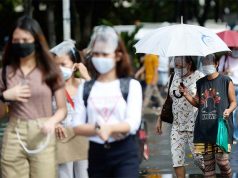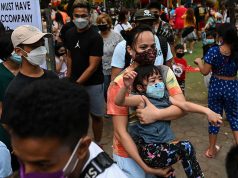The Inter-Agency Task Force for the Management of Emerging Infectious Diseases eased the age restrictions for younger individuals amid the threat of the new variant of the 2019 coronavirus and the possible rise of infections in the country.
The effectivity of these new guidelines and the announcement of the new community quarantine classifications will start on Feb. 1, 2021.
Palace announced on Friday that IATF’s approval covers minors aged 10 to 14 years old who may leave their homes in areas under modified general community quarantine.
In IATF’s resolution 95, it was stated that moving forward, only children below 10 years old and adults over 65 years old are among the individuals required to continue observing home quarantine.
“Any person below ten (10) years old, those who are over sixty-five (65) years of age, those with immunodeficiency, comorbidity, or other health risks, and pregnant women shall be required to remain in their residences at all times; Provided that all activities and movements allowed under other Sections of these Guidelines for the foregoing persons shall continue to be permitted under MGCQ,” the resolution read.
Since the lockdown in March of last year, individuals between the ages of 15 and 65 are allowed to go outside with compliance to the strict health protocols such as wearing face masks and shields and physical distancing.
For areas under the general community version, which is the third strictest quarantine, the implementation of this new rule are up to the local government officials.
“For areas under General Community Quarantine, local government units are enjoined to adopt the same relaxation for age-based restrictions,” the resolution read.
As of now, Metro Manila and the provinces of the provinces of Batangas, Isabela, Lanao del Sur, Davao del Norte, and cities of Santiago, Iloilo, Tacloban, Iligan, and Davao are under GCQ until January 31.
‘Very risky’
Dr. Tony Leachon, ex-consultant for the National Force against COVID-19, expressed caution on the impact of the eased age restrictions, citing the threat of the new virus.
Leachon also cited the high transmission rate in the National Capital Region, which is a high-risk populated area, and the climbing number of deaths since August.
This is very risky.
1. Threat of a highly transmissible new strain
2. R 0 is up 1.10 in NCR
3. The cases average 1,800 to 2,000 ( 1783 latest)
4. Increasing number of deaths.
74 new deaths yesterday
– the 1.99% case fatality rate is the highest since August 2 last year ⚠️ https://t.co/uKrDRbiQPS— Tony Leachon MD (@DrTonyLeachon) January 22, 2021
The new variant identified as B-117 SARS-CoV-2 first identified in the UK is considered 50% to 70% more contagious than the earlier pathogen.
Last week, the first patient carrying the UK variant was confirmed in the Philippines.
The Department of Health reported 1,783 new COVID-19 cases on January 21, bringing the number of total cases to 507,717.
Of these, there are 10,116 deaths and 467,475 have so far recovered.
The NCR topped the regions with the most reported cases with 218,124.
The rest are Calabarzon, Central Luzon, Central Visayas and Western Visayas.
Do children have higher risks?
Studies on whether or not children are more vulnerable to COVID-19 are scant. The World Health Organization previously emphasized that people of all age groups can get infected with it.
Rather, what health organizations have specified are those with underlying medical conditions such as asthma and heart disease are prone to get severely ill with the virus.
“Older people and younger people can be infected by the COVID-19 virus. Older people, and people with pre-existing medical conditions such as asthma, diabetes, and heart disease appear to be more vulnerable to becoming severely ill with the virus,” WHO stated.
An article from Harvard Medical School stated that children who get infected with COVID-19 are normally asymptomatic or manifest mild symptoms such as fever, cough and fatigue. They can therefore spread the infection unknowingly.
However, some children with COVID-19 can develop a severe illness called the multisystem inflammatory syndrome in children (MIS-C).
“It can lead to life-threatening problems with the heart and other organs in the body. Early reports compare it to Kawasaki disease, an inflammatory illness that can lead to heart problems. But while some cases look very much like Kawasaki’s, others have been different,” read the article from Harvard.
Symptoms also vary. These include fever that lasts for a couple of days, stomachache, crackled lips, swollen hands or feet, and skin rashes.










